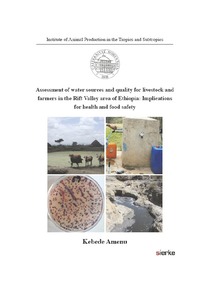Resource information
Adequate access to good quality drinking water is an important prerequisite for the wellbeing
and survival of people. Increasing competition over scarce freshwater resources with
continuous quality deterioration is becoming a serious problem in many developing countries
like Ethiopia, where the technical, socioeconomic and political conditions are impeding the
proper utilization of the required resource. The concern of low quality water is either due to
direct health impacts of poor quality drinking water or a reduction in the palatability of water
for humans or animal consumption. The use of contaminated water in food production and/or
processing can also be a considerable health concern for people. In rural households, water is
used for multiple purposes including income generating activities such as livestock farming.
Generally, the interactions among livestock, water and rural communities are very complex.
Studies addressing the extent of water scarcity and quality problems in Ethiopia in such
contexts are still limited. Therefore, a comprehensive assessment of water utilization by
farmers and their livestock with respect to potential health and food safety impacts was
carried out in two districts of Ethiopia. The specific objectives of the present study were to:
(1) assess the constraints and challenges in meeting the water requirements of livestock kept
by typical rural communities, (2) assess the utilization of water sources by livestock and
people, (3) assess the suitability of water sources for human and livestock consumption based
on microbiological and chemical quality indicators, (4) examine the microbiological quality
of water at household levels and the potential health impacts, and (5) investigate the potential
impacts of poor water quality on the microbiological safety of milk and milk products.
The study was carried out in Lume and Siraro districts, both located in the Rift Valley of
Ethiopia. Methodologically, the study encompassed different components: (1) a questionnaire
survey complemented by focus group discussions with farmers, (2) assessments of the
microbiological and chemical quality of water destined for human and/or livestock
consumption, (3) microbiological assessments of milk and milk products produced and
consumed by the local communities, and (4) a compilation of secondary data focusing on
common human health problems in the districts. The questionnaire survey with 320 randomly
selected farmers, the focus group discussions (n=16) and the compilation of secondary data
were carried out from July to October 2010. Water samples were collected from sources and
household containers from December 2010 to January 2011 and July to August 2011,
corresponding to dry and wet seasons, respectively. During both sampling periods, a total of 25 water sources (sites where water was utilised or fetched for the purpose of human and/or
livestock consumption) were assessed for microbiological and chemical quality parameters. A
total of 126 and 109 water samples from household containers were collected in the dry and
wet season, respectively. In addition, a total of 53 samples of milk and milk products were
collected during the wet season and analyzed for E. coli contamination. Water samples
collected from ground and surface water sources were analysed for total dissolved solids, pH,
manganese, chromium, fluoride, E. coli and total coliforms. The assessed parameters were
selected based on their importance to health or aesthetic aspects of water for human and/or
livestock uses. The water samples from household containers were only analyzed for
microbiological parameters. A summary of disease reports (July 2009-June 2010) was
obtained from the Health Offices of the respective districts to assess the occurrence and
impact of water-related human diseases.
Descriptive statistics were calculated for the questionnaire survey data. Qualitative data
collected in farmers’ group discussions were analyzed by organising the raised issues into
logical categories. Mean ranks were calculated to compare the various constraints for
livestock production mentioned by farmers. Non-parametric statistical tests were used to
compare E. coli counts of water or milk between seasons and districts. The suitability of water
sources for livestock and human consumption was evaluated by comparing the assessed
quality parameters with recommended values.
The study results showed that water sources intended for domestic and livestock uses were
either ground water (hand-dug wells, boreholes) or surface water (river, dugout, surface runoff
from roadsides). Challenges in the provision of water for livestock and/or people were
associated with physical inaccessibility and high seasonal variation in the availability of water
sources. Poor quality water for livestock drinking was rather a concern for communities in the
proximity of urban settlements or industrial establishments. The mismanagement of harvested
rainwater due to indiscriminate access of livestock to the sources was also found to pose high
health risks on both livestock and people.
Taking E. coli as an indicator of faecal pollution, the assessment of water samples showed
that most of the surface water sources were contaminated with faecal materials and did not
meet the WHO guidelines for drinking water quality. On the other hand, groundwater sources
were microbiologically safe, but chemically contaminated with elements such as fluoride and
manganese. In total, 76% of the water sources (n=25 points) assessed in this study failed to comply with WHO guidelines for human drinking water in both, the dry and the wet season
for at least one parameter of health or aesthetic concern. Regarding pH, fluoride, manganese
and chromium, 32% and 20% of the water sources were found unfit for livestock
consumption in the dry and wet season, respectively. Another potential water-related health
risk identified in this study was the considerable re-contamination of water after collection
from sources. This can severely compromise the expected health benefits from the installation
of improved water sources. For the overall assessed water samples from household containers,
it was found that E. coli contamination was higher during the rainy season compared to the
dry season. The microbiological assessment of milk produced and consumed in the study area
showed a considerable contamination with E. coli. Although the correlation between the E.
coli counts of milk and water was weak (Spearman’s rank correlation coefficient r=0.1), the
recorded poor quality water still might have contributed to the low microbiological quality
and safety of dairy products produced and consumed in the area.
According to the secondary data collected from health offices, water-related human health
problems potentially associated with the scarcity, poor quality and mismanagement of water
sources were malaria, diarrhoea and gastro-intestinal parasites. Water-related livestock health
problems were also reported by the farmers to be mainly associated with drinking water from
stagnant dugouts and the industrially polluted Mojo River.
In conclusion, the rural communities in the Rift Valley area of Ethiopia lack reliable access to
safe water sources, with potential adverse health impacts. A possible priority of action that
emanates from this study is a minimization of industrially associated water quality
deterioration through the enforcement of existing environmental protection rules and
regulations. Concurrently, awareness creation of the owners of the industries on the proper
waste disposal mechanisms and environmental accountability should be targeted as one of the
key aspects to alleviate the industry-related water pollution. On the other hand, in order to
minimize the health risk associated with the mismanagement of rainwater harvesting systems,
farmers should be technically supported by the local government in the proper design and
management of the systems. Health education remains a necessary and crucial intervention to
reduce the re-contamination of water. In this respect particularly women should be addressed,
since they are customarily responsible for the collection and handling of water for domestic
consumption.



